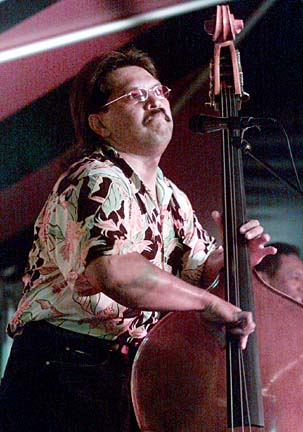


John Koko didn't choose to take up the acoustic bass with the intention of helping perpetuate traditional Hawaiian music. That's how it's worked out, but at the time it was more about being Jerome Koko's kid brother. He and Jerome had decided to perform as a duo like the Brothers Cazimero. Jerome already played 12-string guitar. In the bass tradition
By John Berger
jberger@starbulletin.com"Jerome decided," said John, whose first instrument had been the ukulele. He played several other instruments as well, but he put them all aside and made the acoustic bass his main instrument. He and Jerome performed as My Brother and I.
"We sounded like the Brothers Caz sans Roland's box -- white upright bass and all," Koko said.
Koko had been playing acoustic bass for about three years when Louis "Moon" Kauakahi invited him and Jerome to join the Makaha Sons of Ni'ihau. Two members of the quartet had quit abruptly. Kauakahi wanted to keep the group alive. The year was 1982. Kauakahi and the Koko brothers have been together ever since.

The group -- a trio since 1993 -- has won numerous Hoku Awards. Koko's acoustic bass is an important element in the Sons' sound. The acoustic bass became a staple in popular Hawaiian music in the first part of the last century, and Hawaiian musicians soon picked up the technique of slapping the instrument to emphasize the beat, turning it into a percussion instrument. (Anecdotal evidence suggests that Dan Pokipala may have been the first to use the instrument in a Hawaiian pop group and that William Punohu may have been the first here to use the bass as a percussion instrument.)"I play by ear, and my style is just heart and soul. So as far as plucking (the strings) or slapping, it depends on what feels right for the song," Koko said of his approach to the instrument.
"Every bassist hears his own bass line in a song. For instance, if you gave Robert (Cazimero) a song, and me the same song, we'd come up with totally different bass lines."
It's no surprise that Koko names Cazimero as the bassist he first wanted to emulate. Others he looked up to back in the day were Joe Marshall of the old Sons of Hawaii, Joe Gang of the Gabby Band, and Lyle Ritz.
Younger players now look up to him.
Koko speaks cautiously of the future. There's no question, he says, that the acoustic bass "has a richer fuller sound that's more suitable for traditional Hawaiian music," but he warns that the big instrument is also inherently a major investment -- much more so than an electric bass guitar.
"Everything (is more expensive), from the bass itself to the strings and repairs. I could have bought three new cars already! As for hauling the bass from gig to gig -- it's like taking 10 kids to the zoo, especially when you're in a small car."
Despite the drawbacks, Koko says that the big instrument seems to be secure as an integral part of modern Hawaiian music.
"I think it's getting more popular (than when I started). There are a lot of really good acoustic bass players out there and a lot of good young groups out there playing traditional Hawaiian music.
"I wish there were more."
Featuring the Makaha Sons (Moon, John and Jerome), Tino & the Rhythm Klub and Halau Hula Olana Aston Full Moon
Concert No. 2When: 6:30 p.m. tomorrow
Where: Kapiolani Park Bandstand
Admission: Free
Call: 944-4353
Click for online
calendars and events.